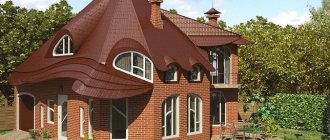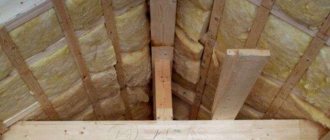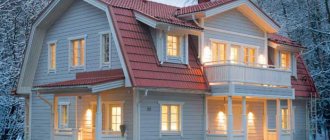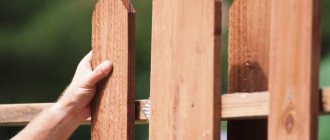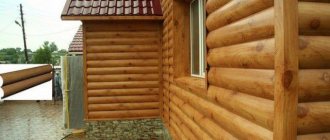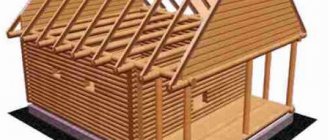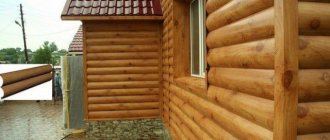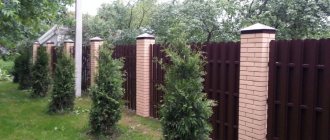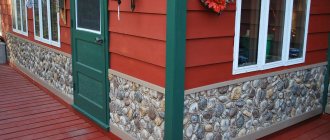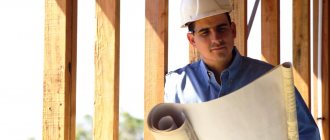Brief characteristics of budget roofs
Modern manufacturers produce a wide variety of different types of the same type of materials. In terms of cost and durability, they differ significantly, or even by an order of magnitude. The comparison table will indicate the technical parameters and cost of the cheapest types of roofing materials of each type.
| Name | Approximate cost, rub./m2 | Warranty period, years |
Ondulin | 300 | 10 |
Asbestos cement slate | 250 | 30 |
Profiled sheet | 330 | 15 |
Metal tiles | 360 | 15 |
Flexible tiles | 400 | 15 |
Materials for inclined rafter systems were considered. Flat roofs are extremely rarely used on private houses, and then only on exclusive, expensive buildings. Flat roofs are used on them, and the coatings are, accordingly, very expensive.
How to save on a roof when choosing a project?
In general, without a project, you can build a roof of the simplest shape on a small house, but even in this case it is worth sketching at least a sketch of the rafter system. When designing independently, choosing a standard project or drawing up technical specifications when ordering an individual one, in order to save money, it is worth considering the following. The simpler, the cheaper - complex hip roofs with dormer windows, kinks and several levels look beautiful. But they cost an order of magnitude more, both in terms of materials costs and in terms of payment for roofing work. It is almost impossible to do such a roof correctly on your own, and mistakes can lead to expensive reconstruction. And you can increase decorativeness through a skillful combination of colors and textures.
Ondulin
It is considered one of the cheapest roofing materials; its commercial name is Euroslate. True, manufacturers do not specify that such slate in Europe is used only for arranging the roofs of outbuildings; it is not found on residential buildings.
Ondulin
It is made from recycled materials (waste paper) and paper production waste (substandard cellulose); modified bitumen is used as a waterproofing impregnation. To change the color, surfaces are painted with permanent dyes. More expensive types of ondulin are colored during sheet pressing, and mineral dyes are added to the mass. At the final stage, stone chips can be glued to the surface.
The shape of ondulin resembles wavy slate. It is wavy coatings that have the highest performance characteristics - maximum strength with minimal thickness, greater resistance to bending loads, minimal risk of leakage, and stability in the direction of water drainage.
Wavy sheets of ondulin
Cheap varieties of ondulin have an extremely limited service life; due to exposure to ultraviolet rays, bitumen loses its plasticity, microcracks appear on the surface, gradually increasing in size, the base breaks through and leaks appear. The surface changes color and lichens and mosses quickly develop on it. The edges of the sheets are deformed and bent, the appearance and tightness of the roof is significantly deteriorated.
Prices for various types of ondulin
Ondulin
Roof covering materials and their technical characteristics
Polymer-coated metal tiles are a durable roofing material
When choosing which roof is best for a low-rise building, consider sheet, roll and piece materials.
Metal tiles
Sheet roofing material is made from steel, aluminum or copper. The wavy profile of the products imitates natural tiles. The sheets have a multi-layer coating, including primer, galvanization, polymer and protective varnish. In terms of the architectural appearance of the roof, the material can be compared to ceramic tiles. The permissible slope during installation is 15°, but coverage less than 20° requires additional sealing of the joints. To fix the sheets, self-tapping screws with rubber gaskets are required so as not to damage the polymer layer.
Advantages:
- durability 30-50 years;
- light weight;
- ease of installation;
- fire resistance;
- attractive look.
Flaws:
- a large amount of waste;
- noisiness;
- high thermal conductivity.
Metal tiles can be laid over the old roof. Installation is simple and quick, and inexpensive. The minimum slope angle is 12°. The price of products depends on the type of polymer coating, the budget processing option is acrylic, the more expensive and reliable is pural.
Ceramic tiles
Ceramic tiles are heavy, but last a long time without the need for repairs
Clay tiles are one of the oldest roofing materials. Modern products are available in various shapes and wave heights, but the high quality remains unchanged.
Advantages:
- strength and durability, service life 150 years;
- excellent heat and sound insulation;
- color fastness to fading;
- environmental friendliness;
- frost resistance;
- respectable appearance.
Flaws:
- significant weight, tile weight 40-60 kg/sq. m;
- high cost - $20-50 per sq. m. m;
- fragility of products.
Tiled roofing requires cleaning of lichen, which grows over time on uneven surfaces. With proper installation, repairs will be required in 15-20 years.
Ondulin
Ondulin sheets can fade in the sun and lose their visual appeal over time.
An inexpensive material that is in demand in private construction. Outwardly, it is similar to slate, but differs in manufacturing technology. Wave sheets are made from pressed cellulose, coated with high-quality bitumen and a layer of quartz sand. Coloring pigments are used to give different shades. The large area of the sheets (200×96 cm) allows for quick installation of the roof.
Advantages:
- moisture resistance;
- frost resistance;
- environmental Safety;
- low price;
- heat and sound insulation;
- light weight.
Flaws:
- subject to combustion;
- fragile, do not step on when laying;
- the color fades.
Ondulin can be installed on a roof with a slight slope - from 6°, but in this case a continuous sheathing is required and an overlap of adjacent sheets of 30 cm; for steeper structures, the timber frame is made in increments of 45-60 cm. Special nails from the same manufacturer are required as fasteners .
Slate
Slate with the addition of polymer materials looks more aesthetically pleasing than asbestos-cement
Asbestos-cement slate is a practical and cheap material. It is cheaper than corrugated sheeting; it covers the roofs of houses, outbuildings, and production workshops. Sheets come in flat and wavy shapes. The second option is stronger due to the stiffening ribs. In private construction, 8-wave sheets are popular. The weight of the material depends on the dimensions; its thickness ranges from 8 to 10 mm.
Advantages:
- low thermal conductivity;
- long service life;
- non-flammability;
- low noise;
- ease of processing;
- low cost.
Flaws:
- the presence of harmful asbestos in the material;
- the sheets are overgrown with moss and require cleaning;
- significant weight.
When calculating the required amount of material, the working size of the slate is taken into account, because the sheets are overlapped. Coating the roof with polymer paint improves the appearance, increases service life and prevents the appearance of vegetation on the material.
Corrugated sheet
Corrugated sheet made of galvanized steel
Steel sheets with a wavy, trapezoidal or square profile that enhances the rigidity of the products. To protect them from external influences, they are galvanized, then painted or coated with a layer of polymers. Products marked “N”, “NS”, “PK” are used for the roof.
Advantages:
- resistance to corrosion and moisture;
- light weight;
- long service life, in fact up to 50 years;
- fire safety;
- affordable price;
- versatility;
- ease of installation.
Flaws:
- noisiness;
- high thermal conductivity;
- difficulty of cutting.
Galvanized corrugated sheets are cheap, but have an unpresentable appearance. They cover outbuildings. Sheets with a decorative protective layer are recommended for roofing in private homes.
Flexible roof
The soft roof is made from fiberglass and bitumen with the addition of crumbs
Soft roofing or flexible tiles are piece and roll products based on fiberglass or fiberglass. The base is impregnated with bitumen and sprinkled with stone chips. The mineral component protects from ultraviolet radiation and adds volume. The products are produced in the form of tiles of various shapes and colors. An adhesive layer is applied on the inside for installation. With a slope of 25° or more, the material can be fixed with nails.
Advantages:
- Possibility of installation on a curved roof;
- economical consumption;
- moisture resistance;
- noise absorption;
- resistance to temperature fluctuations;
- wide range of colors and shapes.
Flaws:
- low fire safety;
- high price;
- the need for a solid base and good ventilation.
The operational reliability of the coating depends on the quality of installation of flexible tiles. The material is laid on a continuous sheathing made of plywood or chipboard. The coating is recommended for roofs of complex shapes.
Roll fused roofing
Roll coating based on fiberglass, bitumen and silicon chips
This group includes materials based on fiberglass or polyester impregnated with bitumen. The surface is treated with a protective layer of dolomite, talc, slate and other crushed minerals. Products are classified according to the base material, which ensures reliable operation. Polyester has the best technical characteristics, but it is more expensive than other products. Roofing felt has the shortest service life and price.
Advantages:
- reliable waterproofing;
- light weight;
- affordable price;
- elasticity.
Flaws:
- flammability;
- use when laying open fire;
- short service life of some varieties.
Fused roofing is used for flat and pitched roofs. A solid base is mounted under it. During operation, the roof should not be subject to loads.
Asbestos cement slate
Traditional material, recently banned for use in developed countries. The reason is that asbestos accumulates in the body and has carcinogenic properties. Such statements are very doubtful; many millions of our compatriots have been living in houses under slate roofs for decades, and no sharp surges in cancer cases have been observed for this reason.
Asbestos cement slate
The service life is 30 years, but in practice it lasts 50 or more. Resistant to aggressive chemical compounds, including urban smog. Modern slate is produced in a wide range of colors - there is an opportunity to improve the designer look of the house.
Slate is a completely non-flammable material
It has no equal in price and is considered the cheapest option. Sheets can have 6–8 waves, thickness up to 5 mm.
Eight-wave slate
Like all roofing materials, slate has a number of disadvantages.
- Heavy weight. The weight of one sheet can exceed 30 kg, this is the highest figure among all types of roofing materials, except cement-sand tiles. Large weights require reinforced load-bearing elements of the rafter system, and this increases its cost. Another problem is that installing heavy slate requires significant physical effort.
Wave slate weight
- Fragility. One of the biggest disadvantages of asbestos-cement slate. After a hail storm, a huge number of through holes appear on the surface; the roof needs to be completely replaced. Another problem caused by fragility is the formation of through cracks with minor fluctuations in the geometry of the rafter system. If the cracks are at the crest of the wave, then there are no big problems. Unpleasant situations appear in cases where a crack appears at the bottom of the wave. All repair work gives only a temporary result; to eliminate leaks, a complete replacement of the damaged sheet is necessary.
Slate is not very durable
Asbestos-cement corrugated slate is not widely popular; it is installed on cheap rural buildings.
Slate roofs are often used on outbuildings
Calculator for calculating the amount of slate per roof
Go to calculations
Prices for different types of slate
Slate
How to make a roof at half the price?
It is most profitable to carry out all the work yourself, for which a simplified form and an undemanding coating are initially laid out. There are not even dozens, hundreds of examples on the forum of how self-builders made roofs for the first time and did an excellent job. Moreover, you can ask all your questions and get answers completely free of charge, and for calculations in the absence of a project, there are a lot of calculators. When it is possible to do without roofers, you can save about a thousand rubles per square meter for a simple roof, and from one and a half thousand if the shape is complex or the coating is expensive. As a rule, the costs of materials and labor are divided equally. That is why, even at the design stage, it is necessary to determine the “wants” and capabilities.
When doing it yourself is not an option, as in a procurement situation, there is only one way out - monitoring, sending out proposals, checking estimates. When drawing up the technical specifications, it is necessary to register all operations; if the roof is “turnkey”, then the estimate should include not only the main work on assembling the rafter system and installing the roofing pie, but also additional work. And these include passages, ventilation ducts, ridges, installation of a drainage system, and filing of soffits. It is not uncommon when the estimate is generalized, the price is attractive, and then it turns out that you will have to pay extra for this work.
Metal profile
In terms of cost, it is not considered the cheapest, but based on the totality of its performance characteristics, this roofing material can be classified as budget.
Roofing corrugated sheets
It can be installed without any problems; it is possible to order sheet sizes taking into account the parameters of the rafter system. Due to this, the consumption of additional elements and hardware is reduced, the amount of waste is minimized, which also has a positive impact on the final cost of the roof. The cheapest metal profile does not have a finishing coating with polymer paints; its surfaces are protected from corrosion only by a zinc layer. The price of roofing largely depends on the thickness of the metal and the amount of zinc per square meter.
Galvanized corrugated sheeting
The corrugated sheet is made from cheap steel alloys; to give it a shape, it is not necessary to have high ductility of the metal. Dimensional accuracy depends on the production equipment used and the professionalism of the personnel. Installation of profiled sheets requires unconditional adherence to technology, otherwise problems will certainly arise during operation.
How to properly cover a roof with corrugated sheeting
Disadvantages - low bending strength, high noise during hail or heavy rain. In windy weather, installation of sheets cannot be carried out - large sizes increase windage. The roof can injure workers, break out of their hands, break, etc. An unpresentable appearance can also be considered a disadvantage, but there is no consensus here.
Corrugated sheet roofing
Prices for corrugated sheets
Corrugated sheet
Selection of roofing material
Qualified specialists directly involved in construction have identified the main characteristics of roofing that must be taken into account to obtain a high-quality result.
- colors;
- form;
- mass of material;
- cost of work;
- price of purchased material;
- strength and reliability of the material.
To purchase a material that suits your home, you need to pay attention to its weight; as an example, you can compare metal tiles with its natural analogue - ceramic tiles. The latter is 10 times heavier, this must be taken into account when designing the roof truss system.
A sufficient number of buyers are misled by focusing on the external characteristics of the product; as a result, other factors are not taken into account and preference is given to material of lower quality and a shorter service life.
To achieve a result that will have attractive external characteristics and qualities necessary for the normal functioning of the roof, professionals recommend paying attention to the following factors:
- the facade and roof must be visually combined;
- access to surface treatment must be provided;
- material price;
- weight of material used;
- appearance that suits the taste of the owner;
- the roof must meet established requirements.
Various materials are used to cover pitched roofs, which will be discussed further.
Metal tiles
A little more expensive than corrugated sheets. The increase in price is explained by the complex geometry of the coating profile. For its manufacture, alloy steels with high ductility are used; the metal must be stretched without the formation of ruptures and microcracks. As for the other technical parameters, they are no different from profiled sheets. The same installation technology, service life, color solutions, types of finishing polymer coatings, etc.
Metal tiles
Metal tile colors
Disadvantages - noise and complexity of installation of multi-slope hip roofs. There is another drawback - mistakes made are sometimes impossible to correct. The sheet will have to be thrown away, but it costs a lot. As for the total estimated cost of covering a roof with metal tiles, it can very conditionally be considered budgetary.
Do-it-yourself metal tile installation
Performance qualities of corrugated sheets
Do-it-yourself corrugated roofing is a common design solution for a small private house, garage, shed or shed, popular among developers due to the excellent performance qualities of the material. Corrugated sheets are made from galvanized steel using the cold rolling method. During the production process, the surface is given a relief, which gives greater horizontal rigidity, and then cut into sheets of standard shape. The popularity of corrugated sheets is explained by the following factors:
- Effective drainage of water from the slope. Installation of corrugated sheeting improves drainage from the roof surface, thanks to gutters directed along the slope. Covering with corrugated sheeting helps solve the problem of snow and liquid retention on roofs with a small slope.
- Versatility. The instructions recommend installing corrugated sheets if the roof has a slope of 12 to 60 degrees. Almost all roofing structures used fall into this range.
- A light weight. One square meter of corrugated sheet weighs 5-7 kg; covering with this material does not increase the load on the rafter frame and foundation of the structure.
- Resistance to mechanical stress. Corrugated sheeting, thanks to the large number of vertical stiffening ribs, has high strength; it can withstand snow loads of up to 1-1.5 m, as well as the weight of a person, without deformation.
- Resistance to corrosion, fungus, mold and other biological factors of destruction. Installation of corrugated sheeting solves the waterproofing problem, does not collapse under the influence of moisture, and lasts for many years.
- Easy installation. You can cover the roof with corrugated sheets yourself; any worker with basic construction skills and a basic set of tools can handle this task.
- Affordable price. A sheet of corrugated sheets costs 400-600 rubles, so covering the roof with this material will not cost that much.
Structure of a profiled sheet
Comparison of the characteristics of load-bearing and wall profiled sheets
Note! Before covering the roof with corrugated sheeting, you need to choose a high-quality, durable material. Corrugated sheets are produced painted and unpainted. The paint or polymer coating that gives color to the material also performs a protective function: it prevents the penetration of moisture and the formation of corrosion. However, if the paint layer and galvanic coating are damaged, the corrugated sheeting begins to quickly rust. The most reliable is considered to be a profiled sheet made of galvanized steel coated with pural.
Flexible tiles
The peak of popularity of flexible (bitumen) shingles is in the past. The main reason for this phenomenon is that it has been used for many years and consumers in practice were able to compare the advertising assurances of manufacturers with actual performance indicators. Experienced roofers are sure that the price of flexible tiles does not correspond to quality indicators. Technical parameters are not at the same high level as the cost.
Photo of soft roofing (flexible tiles)
Of course, this roofing material is much cheaper than piece natural tiles, roofing made of natural stone, copper or aluminum sheets. In comparison, bituminous shingles are considered relatively cheap roofing coverings.
Flexible tiles and their properties
Flaws. After 5-6 years, the appearance of the roof sharply deteriorates, the reason is that to improve the appearance and additionally protect the bitumen from the negative effects of hard UV rays, the surface of the bitumen shingles is covered with stone chips. The front side is rough and retains dust well. As a result, after a short time, moss and lichens grow on the roof, their root system destroys the bitumen and base, and the tiles lose their original physical properties. In addition, the appearance becomes unattractive; areas with different color shades appear on the roof.
Prices for different types of tiles
Roof tiles
Video - Installation of flexible tiles
Roof base
If you do not initially take care of the strength of the base structure, it is unlikely that you will be able to build a good roof. The evidence for this fact lies on the surface: over time, a rafter system that is not designed for load will simply begin to break.
Attention. Keep in mind that the rafter structure takes on the weight of the roof covering, strong wind gusts and snow pressure.
Therefore, when choosing rafter system materials, you must consider:
- type and weight of roof covering;
- weather conditions typical for a particular area;
- thickness of snow masses;
- wind force;
- additional margin of safety.
Only strong roof rafters can provide adequate protection to the building structure. However, you should not prepare the base as if the roof was ready to withstand aircraft shells.
Advice. This requires meticulous planning and optimal decisions.
When choosing a material, both for the roof and for the rafters, keep in mind that the house is an integral system. If the supporting structure of the roof is capable of supporting the roof covering, then the supports - the walls - must correspond to the loads of two links - the covering and the rafters.
Walls, as a rule, are also not held in place by air. Accordingly, the foundation of the house must support the entire above-ground structure.
However, this is an abstract attitude to the issue, which is actually the topic of our article. We think you'll benefit from more precise recommendations.
Step-by-step instructions for installing an ondulin roof
The quality and durability of the roof depends on two factors: the technical parameters of the roofing material and the professionalism of the craftsman.
Ondulin roofing
What should you pay attention to in order to increase the service life of the cheapest pitched roof?
- Location of the house. Ondulin reacts extremely negatively to high temperatures. When heated above +80 °C, it softens greatly, almost completely loses its ability to resist dynamic and static loads, and the edges of the sheets bend upward. If the house is in an open area in the southern regions with a hot climate, then it is recommended to buy more expensive ondulin and always in light colors. A dark roof can heat up to +100 °C and above. This has a very negative effect on the appearance and duration of operation.
- Snow depth and minimum air temperatures. One of the disadvantages of ondulin roofing is that ductility decreases at low temperatures. If there is a lot of snow and severe frosts in winter, then under the influence of these factors the material may crack. In such operating conditions, it is recommended not to use ondulin; it is better to choose metal coatings from the budget range.
A general recommendation is that you should not buy the cheapest roofing materials for your home, regardless of their type.
Fused roofing
.
| Compound | Roll roofing material. The basis: durable, rot-resistant polyester or fiberglass impregnated with oxidized or modified bitumen. Top Coat: a topping of highly ground sand, mica or slate. Bottom covering: special film. . | |
| dimensions | Roll roofing materials, as a rule, come in rolls with the following parameters: Width: 1 meter. Length: 9-10 meters. Roll size: about 10 m2. | |
| Form | Rolled material differs in the coating and quality of bitumen. They all look the same. | |
| Weight | Depending on the class of material, the weight is 4-5 kg. per 1 m2. | |
| Application | Used as a top layer on flat roofs. Mounted by heating with a special burner and overlapped to the base surface. | |
| Advantages | Suitable for roofs with a low slope. Resistant to wind, snow and water loads. Does not require special or complex care. | |
| Flaws | Budget options based on oxidized bitumen are usually short-lived. Installation is carried out using specialized equipment. Store in a strictly vertical position away from heat. | |
| Price | You can buy rolled roofing materials, depending on the manufacturer and composition, from 55 rubles. up to 335 rub. for 1 m2 of material. |
What tools are needed to re-roof?
Re-roofing is not an everyday activity for every owner, so you may not be able to get by with your usual tools. You may need:
- regular and shaped hammers with a spherical tip, possibly a special roofing hammer with a punch;
- hacksaw;
- measuring instruments: center punch, laser compass, universal protractor, level, micrometer;
- drill;
- roofing knife for cutting vapor barrier, waterproofing, insulation, ondulin or flexible tiles.
If you have chosen metal tiles or corrugated sheets for your roof, then it is better to prepare:
- pliers with wide jaws, oval jaws, curved pliers for bending metal sheets;
- scissors for cutting metal;
- punch;
- files of various types for processing cuts;
- bench vice;
- anvil.
Hold each of the tools with your own hands, make sure that you can work with them.
